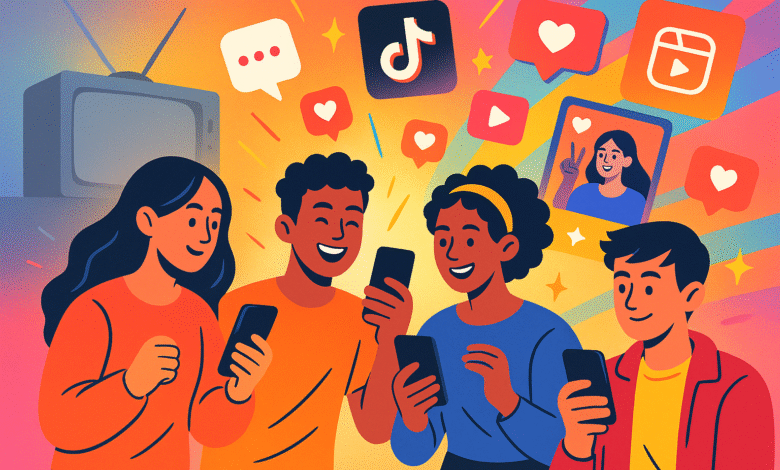Why Short-Form Content (TikTok, Reels) Is Replacing TV for Gen Z
Discover how TikTok, Instagram Reels, and YouTube Shorts are replacing traditional TV for Gen Z. Explore viewing habits, statistics, and digital trends.

The television landscape is experiencing its most dramatic shift in decades, and Gen Z is leading the charge. For the first time in broadcasting history, less than half of 16-24 year olds watch traditional TV weekly, marking a seismic change in how younger generations consume content. Instead of tuning into scheduled programming, Gen Z spends three times more daily on short-form content platforms like TikTok, Instagram Reels, and YouTube Shorts than on traditional broadcast television.
This transformation goes beyond simple preference. It represents a fundamental restructuring of attention patterns, entertainment consumption, and social interaction. While previous generations built their daily routines around prime-time television, Gen Z has embraced a mobile-first generation approach where content consumption happens anywhere, anytime, in bite-sized formats that perfectly match their fast-paced digital lifestyle.
The numbers paint a clear picture: Gen Z viewers spend an average of just 20 minutes per day watching live TV, compared to 1 hour and 33 minutes on video-sharing platforms. This dramatic shift is reshaping not only how content gets created and distributed, but also how brands reach younger audiences, making short-form content the new battleground for attention and engagement.
EXPLORE THE CONTENTS
The Rise of Short-Form Content Platforms
TikTok’s Dominance Among Young Viewers
TikTok has emerged as the undisputed leader in short-form content consumption among Gen Z, with 48% of Gen Z adults using TikTok daily. This represents the highest daily usage rate among all social platforms for this demographic. The platform’s algorithm-driven content discovery has proven particularly effective at keeping users engaged, with Gen Z users spending an average of 95 minutes per day on the app.
The platform’s success stems from its ability to deliver highly personalized content that feels authentic and relatable. Unlike traditional television programming that follows fixed schedules, TikTok adapts in real-time to user preferences, creating an almost addictive viewing experience that 77.7% of Gen Z users describe as engaging.
TikTok’s expansion beyond its original 15-second format to allow videos up to 10 minutes demonstrates the platform’s evolution. However, the heart of TikTok remains short-form video content, typically ranging from 30 seconds to 1 minute, perfectly suited to Gen Z’s preference for quick, impactful content.
Instagram Reels and YouTube Shorts Competition
Instagram Reels follows closely behind TikTok in daily usage, with 40% of Gen Z using the platform regularly. The Meta-owned feature has gained significant traction by leveraging Instagram’s existing user base and offering a familiar interface for short-form content creation and consumption.
YouTube Shorts captures 35% of Gen Z’s daily usage, benefiting from YouTube’s established position as the go-to platform for video content. The integration of Shorts within the main YouTube app provides cross-format visibility, allowing users to seamlessly switch between short-form and long-form content based on their current preferences.
The competition between these platforms has intensified content quality and creator monetization opportunities. Each platform offers unique features: TikTok excels in music integration and viral challenges, Instagram Reels provides sophisticated editing tools and seamless integration with other Instagram features, while YouTube Shorts offers superior monetization options for content creators.
Traditional TV’s Declining Grip on Gen Z
Shocking Statistics on TV Abandonment
The decline of traditional TV viewing among Gen Z represents one of the most dramatic shifts in media consumption history. Recent data reveals that only 48% of 16-24 year olds watch broadcast TV weekly, a sharp decline from 76% in 2018. This represents a 28 percentage point drop in just six years.
Even more striking, close to 1 in 3 Gen Z report they never watch linear TV or traditional television. Instead, the majority (72.9%) spend more than an hour daily on subscription-based streaming services like Netflix, while dedicating significantly more time to social media platforms.
Gen Z viewers now watch an average of just 33 minutes of broadcast TV daily, with only 20 minutes devoted to live television. This stands in stark contrast to their 1 hour and 33 minutes spent daily on video-sharing platforms like TikTok and YouTube.
The Flexibility Factor
The appeal of on-demand content cannot be overstated for Gen Z. Having grown up with instant access to information and entertainment, they expect media that’s fast, accessible, and tailored to their schedules. Traditional TV’s fixed programming schedules feel antiquated to a generation accustomed to consuming content on their terms.
Streaming platforms and social media offer the flexibility that traditional TV cannot match. Users can pause, rewind, skip, and curate their viewing experience in ways that broadcast television never allowed. This control over the viewing experience has become a fundamental expectation for Gen Z consumers.
The mobile-first approach of short-form content platforms perfectly aligns with Gen Z’s lifestyle. They can consume entertainment during commutes, between classes, or while multitasking, making video consumption a seamless part of their daily routine rather than a scheduled activity.
Also Read: Why Gen Z Is Reviving Zines—and How to Start Your Own
Why Gen Z Prefers Short-Form Content
Attention Spans and Information Processing
Contrary to popular belief about shortened attention spans, Gen Z’s preference for short-form content is more about value perception than attention limitations. Research shows that while 61.6% of U.S. Gen Z watch short-form videos on social media, 53.1% also regularly engage with long-form content when it provides genuine value.
The “8-second rule” that marketers often cite tells only half the story. Gen Z will scroll past dozens of posts in seconds, but when something genuinely captures their interest, they’ll engage deeply—watching 45-minute video essays or falling into three-hour YouTube rabbit holes about topics they find compelling.
Short-form content succeeds because it quickly communicates whether the full content will be worth their time. It serves as an efficient filtering mechanism, allowing Gen Z to sample vast amounts of content and invest deeper attention in what truly interests them.
Authenticity Over Production Value
Gen Z values authenticity above polished production, with 61% preferring user-generated content over any other format. This preference explains why content creators and influencers often outperform traditional celebrities and professional productions in capturing Gen Z attention.
User-generated content feels genuine and relatable, coming from real people rather than corporate marketing departments. Gen Z trusts content creators who share authentic experiences, honest product reviews, and unfiltered perspectives over traditional advertising messages.
The preference for authenticity extends to how Gen Z discovers new content. 56% of Gen Z and millennials have watched a movie or show after hearing about it from a content creator, while 53% say social media gives them better viewing suggestions than any streaming app’s algorithm.
Interactive and Social Elements
Short-form content platforms excel at providing interactive experiences that traditional TV cannot match. Features like comments, likes, shares, and direct responses to content creators create a two-way communication channel that Gen Z finds engaging.
Live streaming with interactive features has gained particular popularity among Gen Z, with over 30% engaging with this type of content. The ability to participate in real-time conversations, ask questions, and influence content direction provides a level of engagement that passive TV watching cannot offer.
Social discovery plays a crucial role in content consumption for Gen Z. Rather than relying on traditional media recommendations, they discover content through friends, influencers, and social media algorithms that understand their preferences better than traditional programming executives.
The Creator Economy Impact
Influencer Trust and Relatability
Content creators have fundamentally changed how Gen Z consumes and trusts media. Gen Z places immense trust in influencers they perceive as authentic and relatable, often preferring their recommendations over traditional celebrities or corporate messaging.
The creator economy has democratized content creation, allowing anyone with a smartphone to potentially reach millions of viewers. This accessibility resonates with Gen Z’s values of inclusivity and representation, as they see themselves reflected in diverse content creators rather than just polished media personalities.
Influencer marketing has become particularly effective with Gen Z because it feels like recommendations from friends rather than traditional advertising. 63% of Gen Z say product reviews or ads on social platforms most influence their purchases, demonstrating the power of creator-driven content.
Monetization and Career Opportunities
The creator economy has created new career paths that appeal to Gen Z’s entrepreneurial spirit. Many young people now view content creation as a viable career option, with 58% of Gen Z actively creating and sharing videos online.
Platform monetization features like TikTok’s Creator Fund, YouTube’s Partner Program, and Instagram’s creator bonuses provide financial incentives for quality content creation. This has led to increasingly sophisticated and engaging short-form content that rivals traditional media production values.
The success of content creators has also influenced how traditional media companies approach Gen Z audiences. Many are partnering with influencers or adopting creator-style content strategies to remain relevant to younger viewers.
Platform-Specific Consumption Patterns
TikTok’s Algorithm Advantage
TikTok’s sophisticated algorithm represents a significant advancement over traditional media recommendation systems. The platform’s “For You” page uses machine learning to analyze user behavior patterns, creating highly personalized content feeds that keep users engaged for extended periods.
The algorithm’s ability to surface content from unknown creators alongside established influencers creates opportunities for viral content that traditional media gatekeepers might have overlooked. This democratization of content distribution appeals to Gen Z’s preference for discovering new voices and perspectives.
TikTok’s emphasis on trending sounds, hashtag challenges, and viral content creates a participatory culture where users become both consumers and creators, blurring the lines between audience and content producer.
Instagram Reels Integration Strategy
Instagram Reels benefits from its integration within the broader Instagram ecosystem, allowing content creators to leverage existing followers and cross-promote content across different Instagram features. This integration provides a seamless experience for users who want both short-form and traditional Instagram content.
The platform’s sophisticated editing tools and effects library enable high-quality content creation directly within the app. Instagram’s focus on visual aesthetics aligns well with Gen Z’s appreciation for creative expression and personal branding.
Instagram Reels has also become a discovery engine for longer-form content, with many users finding new Instagram accounts, IGTV videos, or even external websites through Reels recommendations.
YouTube Shorts’ Unique Position
YouTube Shorts occupies a unique position by offering both short-form and traditional long-form content within the same platform. This flexibility allows content creators to experiment with different formats and gives viewers options based on their current time availability and interest level.
The platform’s established monetization infrastructure and creator support programs make it attractive for serious content creators looking to build sustainable careers. YouTube’s revenue-sharing model often provides better financial opportunities than newer short-form platforms.
YouTube Shorts’ integration with the main YouTube search function also provides better content discoverability, as videos can be found through both algorithmic recommendations and direct searches.
Digital Marketing Implications
Brand Adaptation Strategies
Traditional brands are scrambling to adapt their marketing strategies to reach Gen Z through short-form content platforms. The shift requires fundamental changes in messaging, creative approach, and content strategy.
Successful brands on short-form platforms focus on authenticity over production value, entertainment over direct selling, and community engagement over one-way communication. This represents a significant departure from traditional advertising approaches.
Short-form content marketing requires brands to master storytelling within extremely limited timeframes, often needing to capture attention and convey key messages within the first few seconds of a video.
ROI and Engagement Metrics
Short-form content consistently delivers higher engagement rates than traditional long-form content. TikTok leads with a 2.34% engagement rate, making it ideal for brands seeking maximum interaction with their audience, particularly Gen Z consumers.
The lower production costs and higher engagement rates of short-form content often provide better return on investment compared to traditional media buying. Brands can create multiple content variations and test them rapidly to optimize performance.
Performance metrics for short-form content focus on engagement, shares, and conversion rather than simple view counts, providing more meaningful insights into actual audience interest and brand impact.
Future Implications and Trends
Technology and Content Evolution
Augmented reality (AR) and virtual reality (VR) technologies are beginning to influence short-form content, with over 47% of Gen Z engaging in these immersive experiences. These technologies will likely become standard features in content creation tools.
Artificial intelligence is increasingly being used to enhance content creation, from automated editing tools to AI-generated music and effects. This democratization of production tools will likely lead to even higher quality user-generated content.
Interactive content formats, including choose-your-own-adventure style videos, are gaining popularity with over one-third of Gen Z engaging with this type of content, suggesting future evolution toward more immersive and personalized viewing experiences.
Industry Adaptation Requirements
Traditional media companies are investing heavily in short-form content creation and creator partnerships to remain relevant to Gen Z audiences. This includes launching dedicated short-form content divisions and hiring social media native talent.
Streaming services are beginning to integrate short-form content features and social elements to compete with social media platforms. This hybrid approach may represent the future of digital entertainment.
Educational institutions and professional development platforms are adopting short-form content for microlearning, recognizing that Gen Z prefers bite-sized, focused learning experiences over traditional long-form educational content.
Conclusion
The replacement of traditional TV with short-form content among Gen Z represents more than a simple preference shift—it’s a fundamental restructuring of how an entire generation consumes entertainment, discovers information, and engages with brands. With Gen Z spending three times more daily on platforms like TikTok, Instagram Reels, and YouTube Shorts than on broadcast television, the writing is clearly on the wall for traditional media companies. The success of short-form content stems from its alignment with Gen Z’s values: authenticity over production value, flexibility over fixed schedules, and interactive engagement over passive consumption. As this mobile-first generation enters their peak purchasing years, brands and content creators who master short-form content strategies will be best positioned to capture their attention and loyalty. The future belongs to those who can tell compelling stories in seconds, not hours.







